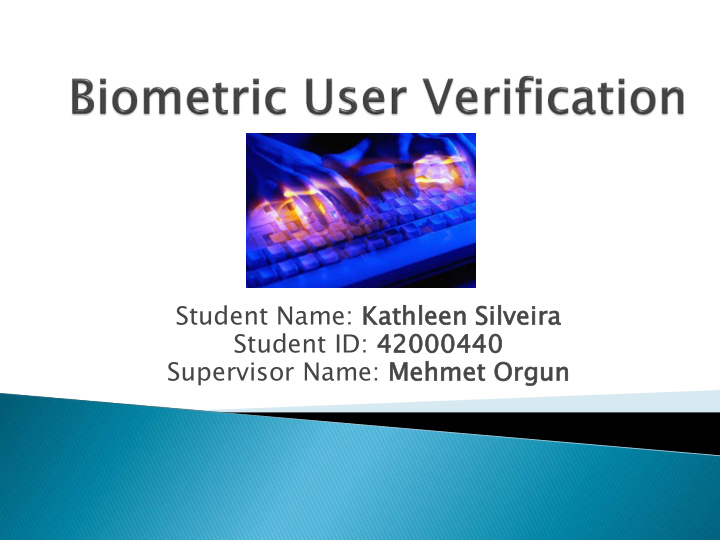



Student Name: Kathlee een n Silveira ra Student ID: 420004 0440 Supervisor Name: Mehmet t Orgun un
1. Introduction 2. Functional Design 3. Technical Design 4. Evaluation 5. Conclusion 2
What is Biometrics? What is Keystroke Dynamics? Aims, Outcomes and Significance Methodology Past Work 3
Bio (life) and metric (to measure) ◦ Biometric is a method to measure certain human characteristics unique to a person, permanent, measurable, not transferable or shared 4
User A typing the same phrase 2 users typing the same phrase 5
Aims Ou Outcomes comes Implement and test a Prototype of prototype of Keystroke Keystroke Dynamics Dynamics based on an application algorithm by (Teh, Teoh Final Report and et al. 2010) Presentation Signifi ificance cance increase security by verifying online users who attempt to login reducing identity thefts or forgery 6
Plann nnin ing Setup up envi viro ronme ment Regi gistr tration ation Screen Application Component onent Test t (Regi gistr tratio ation) n) Verifi fica cati tion on Screen Application Component onent Test(Ve t(Verifica ificati tion) n) System m Integr gration ation Testi ting ng Analysis is & Docume ment ntation ation 7
Select ect 1 Biomet metri ric: Keyst stro roke e Dyna namic mics Select ct 2 B 2 Biome ometri trics cs based on ease of implementation • Fingerprin ngerprint ( from Conventional & physiological group) • Keyst strok roke e Dynamics amics (from Emerging & behavioural group) Research search variou ious s Biometr metric ic Technologies nologies 8
The Concept of a Feature Vector Basic outline of the process The algorithm 9
Dwell ell time me (D1): ): D1= R1- P1 Flight ight time e (D2): ): D2 = P2 - P1 Flight ight time e (D3): ): D3 = P2 - R1 Flight ight ti time e (D4): ): D4 = R2 - R1 10
2 parts of the process: ◦ Enrolment (One-time) ◦ Verification (Recurring) Enrolmen olment t Mode Verifi rificati tion on Mode 11
Enrolment ◦ Use the Feature Vector to generate a template (mean, standard deviation, number of samples, summation) ◦ Store the template Verification ◦ Gaussian probability density function (GPD) is used to compute the similarity score between the reference template and the test data template ◦ output score of GPD has range of [0,1] 12
Basic Architectural Pattern Technologies Considered Component Design 13
Modular design allows components to be plugged in High-level Architectural Pattern A1. Input/Output Layer A2. Application Layer A3. Storage Layer 14
• Applets • Requirement: • Swings Algorithm Input t / suggested to Output t • Java command line capture time using Layer • JAAS nanoseconds • JavaScript • Out of the technologies considered, only Applic icatio ation n • Java Swings could Layer capture time in nanoseconds Storage age • Oracle Database Layer 15
Test t Environment onment Deve velopme ment nt Input t / Output ut Layer er Applica cation tion Layer er Stora rage ge Oracle Oracle Layer er Database se Database se 16
Experiment Setup Preliminary Results 17
Acquisition of the test-data ◦ 10 volunteers from the IT department for testing ◦ Registration: Page to capture the user’s keystroke patterns ◦ Verification: Login into the system during which the real-time keystroke pattern was matched against the stored template to allow or deny the user. Captured user data useful in testing the system Captured user data is also useful for analysing patterns to obtain better algorithm 18
With given time of 1 semester, tests conducted with 6 volunteers were not sufficient to provide reliable metrics like FAR (False Acceptance Rate) and FRR (False Rejection Rate) Before a large scale testing occurs, there are other issues like ethics and the user’s consent. The proto totyp type e is ready ady for more e tests ts using ing mo more e users. ers. 19
Summary Lessons Learnt & Future work 20
The Prototype of Keystroke Dynamics is ready for further evaluation Components are modular to allow replacements for other technology / algorithms / metrics Swings was the chosen technology as it could capture time in nanoseconds 21
Les essons sons Lea earnt rnt ◦ technology: what other technologies could be considered (e.g., Platform as a Service), precision of keystroke timings ◦ project management: how the project could have been structured to optimize it (e.g., advertised for voluntary users in a wider population) Future ture wo work ◦ augmenting the implementation to be more robust ◦ inter-operable with other key Out-Of-The-Box (OOTB) Identity and Access Management (IAM) solutions and products ◦ the use of multiple biometrics 22
23
24
Recommend
More recommend